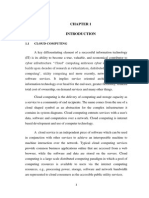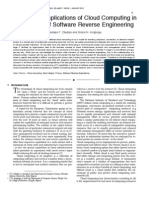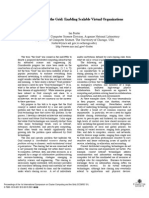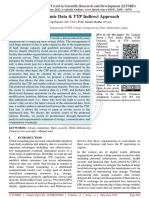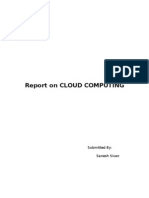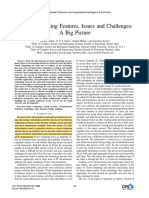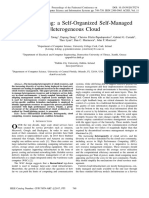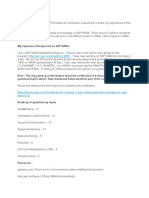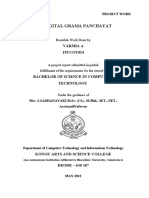Professional Documents
Culture Documents
Dynamic Resource Allocation For Media Streaming in Cloud Storage
Original Title
Copyright
Available Formats
Share this document
Did you find this document useful?
Is this content inappropriate?
Report this DocumentCopyright:
Available Formats
Dynamic Resource Allocation For Media Streaming in Cloud Storage
Copyright:
Available Formats
Volume 8, Issue 4, April – 2023 International Journal of Innovative Science and Research Technology
ISSN No:-2456-2165
Dynamic Resource Allocation for Media Streaming in
Cloud Storage
1
Deepashree H. L
Assistant Professor,
Department of Computer Science and Engineering
PES University, RR Campus
Abstract:- Media streaming applications have recently II. LITERATURE SURVEY
been envisioned to a large number of users in the
Internet. This huge demand creates a burden on From survey it demonstrated that numerous
centralized data centers at media content and has individuals getting to web are pulled in towards media
turned out to a research area. The problem becomes streaming. This massive interest makes a weight on
more critical with the increasing demand for higher bit gathered server ranches at media content supplier, for
rates required for the growing number of higher- instance, Video-on-Demand (VoD) suppliers will deal with
definition video quality desired by consumers. Most of the required QoS guarantees. The issue ends up being more
the existing cloud providers employ a pricing model for fundamental with the extending enthusiasm for higher piece
the reserved resources that is based on non-linear time- rates required for the creating number of better quality
discount tariffs Such a pricing scheme offers discount video.
rates depending non-linearly on the period of time
during which the resources are reserved in the cloud
this can be resolved by Prediction-Based Resource
Allocation algorithm the proposed system is an android
application based, as smart phones are more in use.
Keywords: Video; Streaming; Media; Resource;
Prediction-Based.
I. INTRODUCTION
Media streaming have recently pulled a countless
people on network. Streaming media is multimedia that
is perpetually gotten by, showed to an end-customer while
being passed by a supplier. The verb “to stream” is the
methodology of conveying media. A customer media
player can start to play the information, before the whole
record has been transmitted. Recognizing conveyance
procedure from the media appropriated applies especially to
information transfers systems, as a huge part of the
conveyance frameworks are either intrinsically streaming
(TV) or intrinsically non-streaming (Books). The Fig 1 Media Streaming
expression "streaming media" can apply to media other
than video and sound, for example, real-time text, which is Video delivery frameworks, for example, YouTube,
viewed as "streaming content"..The key particular issues Netflix, Hulu, and so on., have increased extraordinary
related to streaming were as one is Having sufficient CPU prevalence on the Internet these days. As per "Cisco Visual
power and transport transfer speed to bolster the required Networking Index: Forecast and Methodology .This does
information rates exclude video traded through distributed (P2P) record
sharing.. Few observations from different person are listed
Another one is Making low-inactivity interfere with below:
ways in the working framework to avert cradle under run
.Streaming media is logically being consolidated with use of S. Islam, J. Keung, K. Lee, and A. Liu
internet systems administration. For instance, YouTube A forecast technique has been proposed concerning
support social participation in webcasts through upcoming CPU usage design requests in view of neural
components, for occurrence, live visit, online studies, and so systems administration and direct relapse that is of
forth. Besides, streaming media is intelligently being enthusiasm for e-trade applications. However, the majority
utilized for social business and e-learning. of the studies foresee the normal streaming limit requests,
IJISRT23APR820 www.ijisrt.com 900
Volume 8, Issue 4, April – 2023 International Journal of Innovative Science and Research Technology
ISSN No:-2456-2165
few work have likewise concentrated on the As it observed from related work, we find that the
unpredictability of the limit request, i.e., the interest change issue of cost minimization for media content suppliers, as
at any point of time in future, which yields more exact far as money related costs by considering the penalties
danger variables. The forecast of streaming transmission brought about by the over-provisioned or under-
capacity interest is outside the extension. provisioned held assets, and the development buy of assets
at cloud suppliers for simply the privilege time allotment.
Filali, A. S. Hafid, and M. Gendreau
Applications using Grid computing framework more In order to overcome the cost minimization problem,
often than not require assets distribution (e.g., data the resources are allocated by using the prediction based
transmission and CPU) to fulfill their nature of allocated implemented by PBRA algorithm and also
administration (QoS) prerequisites. Given the dynamic way extending this algorithm with load balancing concept. As
of matrix figuring, QoS backing and adjustment must be a many of the people use the android phone in order to make
high need to effectively support those applications. A ease of access is done by implemented an android module.
versatile asset provisioning plan is displayed that enhances The first design stage in which the basic approach for
the data transfer capacity use while fulfilling the required solving the problem is selected is called as System
levels of QoS. Boost of data transfer capacity(bandwidth) designing. In the system design, the general structure and
usage which helps the cloud service suppliers to diminish style are taken. The architecture is the general organization
their costs and expand their incomes. of the system into components called subsystems. The more
definite choice which are made in later stages are based on
Proposed Method the context of architecture.
Today, streaming resource has turned into a
component offered by numerous cloud suppliers to The system design gives the abstract representation of
substance suppliers with an escalated data transfer capacity data flow, inputs and yields of the system. It additionally
request. The streaming of media substance to content portrays the structure, behavior and views of the system. It
viewers situated at various geological locales at ensured incorporates a physical design where it explains how data is
information rate is a part of the administration offered by input into a system, how it is confirmed/validated, how it is
the cloud supplier. The basic method for having so as to prepared, and how it is shown.
execute this administration in the cloud is different server
farms inside the systems of the entrance association The first design stage in which the basic approach for
suppliers (Internet Service Providers) situated at different solving the problem is selected is called as System
geological areas Cloud service provider might need to designing. In the system design, the general structure and
arrange contracts with various ISPs to co-find their servers style are taken. The architecture is the general organization
into the systems of those ISPs. of the system into components called subsystems. The more
definite choice which are made in later stages are based on
In such manner, another gathering of people have the context of architecture.
centurion contemplating distinctive sorts of agreements
among cloud service provider and ISPs for minimizing the The system design gives the abstract representation of
costs of cloud suppliers. To the best of the insight, not data flow, inputs and yields of the system. It additionally
many studies have explored the issue of improving asset portrays the structure, behavior and views of the system. It
reservation with the goal of reducing the financial expenses incorporates a physical design where it explains how data is
for substance suppliers. A decent illustration is exhibited, input into a system, how it is confirmed /validated, how it is
wherein asset reservation advancement issue is planned to prepared, and how it is shown.
minimize the expenses of substance suppliers, alleged
cloud purchasers, utilizing a stochastic programming
model. All of the whole of issue plan, unverifiable interest
and dubious cloud suppliers' asset costs are considered.
Conversely, the advancement issue figured in our work
considers a given likelihood appropriation capacity got
from previously stated studies for the expectation of media
spilling requests. Moreover, the issue of cost minimization
is tended to by using the marked down rates offered in the
non-direct taxes Equations.
IJISRT23APR820 www.ijisrt.com 901
Volume 8, Issue 4, April – 2023 International Journal of Innovative Science and Research Technology
ISSN No:-2456-2165
Fig 2 CSP Cloud Service Provider
In this architecture, there are Data owner, Cloud and exhibited that improves the data transfer capacity usage
Web Server and Mobile application. Data owner registers while fulfilling the required levels of QoS. In, an
with cloud which in turn cloud allocates certain memory enhancement structure for settling on element asset
space for that data owner, now data owner can use allocated allotment choices under dangerous and dubious working
space for uploading video by logging with the given situations was produced to maximize income while
credentials. With the help of http the cloud uploads video decreasing working expenses. The streaming of media
onto the web server. Web server contains the details of how content to content viewers situated at various land locales at
many users have watched the video and other details. ensured information rate is a part of the administration
Mobile application is used by end-user in order to watch offered by the cloud supplier. The normal method for
the uploaded video without any delay or disturbance. Cloud executing this administration in the cloud is by having
server will contain the details of the data owner, available different server farms inside the systems of the entrance
storage space and alerts the data owner with the remaining association suppliers (Internet Service Providers, ISPs)
space. situated at proper topographical areas .Cloud administration
suppliers may need to arrange contracts with various ISPs
Dynamic resource allocation algorithm is to co-find their servers into the systems of those ISPs. In
implemented in cloud as it takes care of allocating the such manner, concentrated on various sorts of agreements
resource using both reservation plan and demand plan. between cloud administration suppliers and ISPs with the
reason for minimizing the costs of cloud providers. As an
Prediction-Based Resource Allocation algorithm and outcome an interesting outline methodology is to look at
load balancing concept: the asset reservation issue from the perspective of content
suppliers in minimizing their expenses.
Prediction Based Resource Allocation
(PBRA) that minimizes the monetary expense of asset Demand Based Android App
reservation in the cloud by maximally abusing marked This folder contains the java files for the android
down rates offered in the tariffs, while guaranteeing that application, layout design, string value folder, and also a
adequate assets are saved in the cloud with some level of manifest for android in XML. This folder contains
trust in probabilistic sense. The prediction of CPU use and following sub-folders:
client access interest for electronic applications has been
broadly seen. An versatile asset provisioning plan is
IJISRT23APR820 www.ijisrt.com 902
Volume 8, Issue 4, April – 2023 International Journal of Innovative Science and Research Technology
ISSN No:-2456-2165
SRC: This folder contains all the Java Script files where
the android user register in server, view videos, submit
their opinion.
RES: This folder contains the details of the application
icon, layout in smart phone, Application name and
menu details.
LIBS: This folder contains the reqiuierd jar file,
android-support-v4
Demand Based Dynamic Resource Allocation
This folder contains the java files for data owner and
server side services. This folder contains following sub-
folders
SRC: This folder contains all the Java Script files where
the data owner requests for space in cloud and other
possible user actions.
JRE System Library: This folder contains the required
jar files, like resources, dsns and so on.
Experimental Results
The expected outcome from this project is to develop
a system that allows the data owner to register in cloud and
allocate a sufficient memory space to the data owner Fig 4 Shows Comment Sent Successfully
(Reserved Plan), cloud server should provide a threshold
limit for memory space. When the data owner has used Interpretation
enough memory it should allocate the random memory The performance evaluation is done by comparing the
(Demand Plan). existing resource allocation plan and implemented
reservation plan. Existing resource allocation plan in cloud
The web server should maintain the list of available consists of two methods namely; first one fixed reserve
videos and load balancing (no. of users increasing on time), time, Second one is demand plan, where in the user
view the comments, provides option for admin login. dynamically request for resource when they need.
The end-user must be able to watch the video online
without downloading it and without storing it (thus saves
both memory and time of downloading it), comment about
the watched video.
Fig 5 The Graph showing the Resource Cost against Time
in Various Methods
III. CONCLUSION
In this anticipate I have concentrated on quality to
upgrade and diminishing the primary expense of the system
which is passed on. The postulation traverses the ranges of
distributed computing, mixed media conveyance, and
financial matters. The cloud environment gives flawless
Fig 3 Shows Screen for Playing Video base to any utilization. It additionally gives better video
IJISRT23APR820 www.ijisrt.com 903
Volume 8, Issue 4, April – 2023 International Journal of Innovative Science and Research Technology
ISSN No:-2456-2165
sharing in internet organizing, where the transmissions of
video are exceedingly done. This project gives the layout of
the streaming and sharing used by various strategies. The
idealizing of recordings can be enhanced by utilizing
versatile video coding proficiently furthermore by
anticipating clients conduct. Also the proposed system can
be utilized by the organization when they need to share
only set of videos with the authorized users of the
organization.
According to the proposed system android user can
only watch the video on their smart devices, the future
enhancement can be providing the option for uploading the
video and also data owner services in the smart devices.
REFERENCES
[1]. Amr Alasaad,Kaveh Shafiee,Hatim Behairy and
Victor C.M.Leung,” Innovative Schemes for
Resource Allocation in the Cloud for Media
Streaming Applications”, IEEE Transactions on
Parallel and Distributed Systems,Volume:26,Issue:4,
April.1.2015
[2]. S. Chaisiri, B-S Lee, and D. Niyato, “Optimization
of Resource Provisioning Cost in Cloud
Computing,” in IEEE Transactions on Services
Computing, vol. 5, no. 2, pp. 164–177, 2012
[3]. Yonggang Wen, Xiaoqing Zhu,Joel
J.P.C.Rodrigues,Chang Wen Chen,"Cloud Mobile
Media:Reflections and Outlook",IEEE
TRANSACTIONS ON MULTIMEDIA,
vol.16,no.4,June 2014
[4]. S. Islam, J. Keung, K. Lee, and A. Liu, “Empirical
Prediction Models for Adaptive Resource
Provisioning in the Cloud,” in Future Generation
Computer Systems, vol. 28, no. 1, pp. 155–162,2012
[5]. D. Kusic and N. Kandasamy, “Risk-Aware Limited
Looka-head Control for Dynamic Resource
Provisioning in Enterprise Computing Systems,” in
Cluster Computing, vol. 10, no. 4, pp. 395–408,
2007
[6]. A. Filali, A. S. Hafid, and M. Gendreau, “Adaptive
Resources Provisioning for Grid Applications and
Services,” in Proc. Of ICC Conference, pp. 186 –
191, 2008
IJISRT23APR820 www.ijisrt.com 904
You might also like
- Paper 2Document8 pagesPaper 2Saravanan ThangavelNo ratings yet
- Privacy Preserving Intermediate Datasets in The CloudDocument83 pagesPrivacy Preserving Intermediate Datasets in The CloudSuganya PeriasamyNo ratings yet
- Chapter 1Document57 pagesChapter 1Kalyan Reddy AnuguNo ratings yet
- K-Means Based Error Resilient Video Streaming in Peer To Peer NetworksDocument5 pagesK-Means Based Error Resilient Video Streaming in Peer To Peer NetworksInternational Journal of Application or Innovation in Engineering & ManagementNo ratings yet
- The Privacy Implications of Cloud Computing in The Context of Software Reverse EngineeringDocument7 pagesThe Privacy Implications of Cloud Computing in The Context of Software Reverse EngineeringJournal of Computer Science and EngineeringNo ratings yet
- Cdns Content Outsourcing Via Generalized CommunitiesDocument15 pagesCdns Content Outsourcing Via Generalized CommunitiesSaiprasanthi RakeshNo ratings yet
- Paper 3Document6 pagesPaper 3Academic HubNo ratings yet
- What Is Cloud Computing? Cloud Computing Is The Use of Computing Resources (Hardware andDocument74 pagesWhat Is Cloud Computing? Cloud Computing Is The Use of Computing Resources (Hardware andSanda MounikaNo ratings yet
- Grid Computing: Isoc Member Briefing #11Document4 pagesGrid Computing: Isoc Member Briefing #11devapriyabtechNo ratings yet
- Sunderdeep Group of Institutions Faculty of Engineering & Technology, GhaziabadDocument16 pagesSunderdeep Group of Institutions Faculty of Engineering & Technology, Ghaziabadamitnand7No ratings yet
- CLOUD COMPUTING A PAPER PRESENTATION ON CLOUD COMPUTINGDocument8 pagesCLOUD COMPUTING A PAPER PRESENTATION ON CLOUD COMPUTINGGonella NagamallikaNo ratings yet
- Infrastructure As A Service Security IssDocument5 pagesInfrastructure As A Service Security IssAnica PopovicNo ratings yet
- The Anatomy of The GridDocument2 pagesThe Anatomy of The GridainugiriNo ratings yet
- V3i102 PDFDocument7 pagesV3i102 PDFIJCERT PUBLICATIONSNo ratings yet
- Cloud ComputingDocument13 pagesCloud ComputingNurlign YitbarekNo ratings yet
- A Health Research Collaboration Cloud ArchitectureDocument16 pagesA Health Research Collaboration Cloud ArchitectureAnonymous roqsSNZNo ratings yet
- The Ultimate Guide to Unlocking the Full Potential of Cloud Services: Tips, Recommendations, and Strategies for SuccessFrom EverandThe Ultimate Guide to Unlocking the Full Potential of Cloud Services: Tips, Recommendations, and Strategies for SuccessNo ratings yet
- Cloud Computing Technical Challenges and CloudSim FunctionalitiesDocument5 pagesCloud Computing Technical Challenges and CloudSim FunctionalitiesIjsrnet EditorialNo ratings yet
- System Observability and Monitoring For Multi Cloud Native Network Service Based FunctionDocument9 pagesSystem Observability and Monitoring For Multi Cloud Native Network Service Based FunctionIJRASETPublicationsNo ratings yet
- CSP Dynamic Data and TTP Indirect ApproachDocument5 pagesCSP Dynamic Data and TTP Indirect ApproachEditor IJTSRDNo ratings yet
- Clearing The Clouds On Cloud Computing S-51490823 PDFDocument6 pagesClearing The Clouds On Cloud Computing S-51490823 PDFFisehaNo ratings yet
- Report Cloud ComputingDocument15 pagesReport Cloud ComputingsaneshsivanNo ratings yet
- Key Factors Increasing Trust in Cloud Computing Applications in The Kingdom of BahrainDocument9 pagesKey Factors Increasing Trust in Cloud Computing Applications in The Kingdom of BahrainM Faizan NasirNo ratings yet
- To Improve Data Storage Security Levels in The CloudDocument5 pagesTo Improve Data Storage Security Levels in The CloudEditor IJRITCCNo ratings yet
- Edge-Based Auditing Method For Data Security in Resource-ConstrainedDocument10 pagesEdge-Based Auditing Method For Data Security in Resource-Constrained侯建No ratings yet
- Design_and_Deployment_of_a_Hybrid_CDN-P2P_System_fDocument11 pagesDesign_and_Deployment_of_a_Hybrid_CDN-P2P_System_fcephas01No ratings yet
- Futureinternet 15 00392Document5 pagesFutureinternet 15 00392felipaoNo ratings yet
- A - Practical - Integrated - Multi-Criteria - Decision-Making - Scheme - For - Choosing - Cloud - Services - in - Cloud - SystemsDocument14 pagesA - Practical - Integrated - Multi-Criteria - Decision-Making - Scheme - For - Choosing - Cloud - Services - in - Cloud - SystemsSmith Dávila ReymundoNo ratings yet
- Data Center Cloud WPDocument12 pagesData Center Cloud WPaajayhsharmaNo ratings yet
- Papper 13 Carcteristicas Escenciale PDFDocument8 pagesPapper 13 Carcteristicas Escenciale PDFSebastian GuerraNo ratings yet
- UNIT-1 Introduction & Cloud InfrastructureDocument26 pagesUNIT-1 Introduction & Cloud Infrastructure1030Prakash RAJUNo ratings yet
- Review Article: Foundations and Technological Landscape of Cloud ComputingDocument32 pagesReview Article: Foundations and Technological Landscape of Cloud Computingbebeto MNo ratings yet
- 2017F274Document10 pages2017F274tien nguyenNo ratings yet
- Hierarchical Comparison and Classification of P2P Systems Based On Architectural DesignDocument10 pagesHierarchical Comparison and Classification of P2P Systems Based On Architectural DesignSaddam ShahNo ratings yet
- Golightly Et Al 2022 Adoption of Cloud Computing As Innovation in The OrganizationDocument17 pagesGolightly Et Al 2022 Adoption of Cloud Computing As Innovation in The OrganizationClaudio Rios RojasNo ratings yet
- Cloud Computing - A Comprehensive Definition ExplainedDocument9 pagesCloud Computing - A Comprehensive Definition ExplainedasNo ratings yet
- Web-Based Collaborative Big Data Analytics On Big Data As A Service PlatformDocument4 pagesWeb-Based Collaborative Big Data Analytics On Big Data As A Service PlatformZbryxnK AntonyNo ratings yet
- Paper 30 PDFDocument34 pagesPaper 30 PDFSebastian GuerraNo ratings yet
- Cloud Computing Security Challenges and SolutionsDocument4 pagesCloud Computing Security Challenges and SolutionsDiksha ChaudhariNo ratings yet
- 69 - Developing Middleware For Hybrid Cloud Computing ArchitecturesDocument3 pages69 - Developing Middleware For Hybrid Cloud Computing ArchitecturesLARS Projetos & Soluções em Engenharia ElétricaNo ratings yet
- Net-Centric Computing The Future of Computers andDocument16 pagesNet-Centric Computing The Future of Computers andGodsmiracle O. IbitayoNo ratings yet
- Cloud Computing - Architecture, Platform and Security Issues: A SurveyDocument12 pagesCloud Computing - Architecture, Platform and Security Issues: A Surveysabbir hossainNo ratings yet
- 07752801Document7 pages07752801Chehira DoghmenNo ratings yet
- Survey Research On QoS of P2P Reliable Streaming MediaDocument8 pagesSurvey Research On QoS of P2P Reliable Streaming Media4hgtrb0xNo ratings yet
- Cloud ComputingDocument26 pagesCloud ComputingHusnain AliNo ratings yet
- Cloud Computing SystemsDocument6 pagesCloud Computing SystemsJOAQUIN LAZO ROJASNo ratings yet
- Paper 6-An Analysis of Security Challenges in Cloud ComputingDocument9 pagesPaper 6-An Analysis of Security Challenges in Cloud ComputingEditor IJACSANo ratings yet
- Cloud Resources ProvisioningDocument13 pagesCloud Resources ProvisioningVaishnavi ChockalingamNo ratings yet
- (2017) Comparative Study of Traditional Software Development and Development On CloudDocument5 pages(2017) Comparative Study of Traditional Software Development and Development On CloudShamine NaziraNo ratings yet
- Security and Privacy Challenges in Cloud Computing EnvironmentsDocument9 pagesSecurity and Privacy Challenges in Cloud Computing EnvironmentsAbdataa waaqaaNo ratings yet
- Cloud Computing Delivery Architecture ModelsDocument7 pagesCloud Computing Delivery Architecture ModelsKarthik KrishnamurthiNo ratings yet
- Multi-Level TSN Using DDS for Synchronized Three-Phase Data TransferDocument11 pagesMulti-Level TSN Using DDS for Synchronized Three-Phase Data Transfertiegang liuNo ratings yet
- Unit 1 (1)Document85 pagesUnit 1 (1)23mz02No ratings yet
- Cloud Computing: Harnessing the Power of the Digital Skies: The IT CollectionFrom EverandCloud Computing: Harnessing the Power of the Digital Skies: The IT CollectionNo ratings yet
- CloudComputing Comit Published Csit111704Document10 pagesCloudComputing Comit Published Csit111704PrinceTSMNo ratings yet
- A Study of Infrastructure Clouds: International Journal of Computer Trends and Technology-volume3Issue1 - 2012Document5 pagesA Study of Infrastructure Clouds: International Journal of Computer Trends and Technology-volume3Issue1 - 2012surendiran123No ratings yet
- 19 ResourceAllocationinCloudComputing-AnExposeDocument10 pages19 ResourceAllocationinCloudComputing-AnExposeNguyen Khac ChienNo ratings yet
- T-05 Distributed SDN Control - Survey 2018 PDFDocument22 pagesT-05 Distributed SDN Control - Survey 2018 PDFEladhio BurgosNo ratings yet
- Grid Computing: ST - Ann'S College of Engg & Tech CHIRALA-523187Document11 pagesGrid Computing: ST - Ann'S College of Engg & Tech CHIRALA-523187api-19799369No ratings yet
- Standard implementation in cloud forensics helps investigationsDocument5 pagesStandard implementation in cloud forensics helps investigationsMarco ProañoNo ratings yet
- Parastomal Hernia: A Case Report, Repaired by Modified Laparascopic Sugarbaker TechniqueDocument2 pagesParastomal Hernia: A Case Report, Repaired by Modified Laparascopic Sugarbaker TechniqueInternational Journal of Innovative Science and Research TechnologyNo ratings yet
- Smart Health Care SystemDocument8 pagesSmart Health Care SystemInternational Journal of Innovative Science and Research TechnologyNo ratings yet
- Visual Water: An Integration of App and Web to Understand Chemical ElementsDocument5 pagesVisual Water: An Integration of App and Web to Understand Chemical ElementsInternational Journal of Innovative Science and Research TechnologyNo ratings yet
- Air Quality Index Prediction using Bi-LSTMDocument8 pagesAir Quality Index Prediction using Bi-LSTMInternational Journal of Innovative Science and Research TechnologyNo ratings yet
- Smart Cities: Boosting Economic Growth through Innovation and EfficiencyDocument19 pagesSmart Cities: Boosting Economic Growth through Innovation and EfficiencyInternational Journal of Innovative Science and Research TechnologyNo ratings yet
- Parkinson’s Detection Using Voice Features and Spiral DrawingsDocument5 pagesParkinson’s Detection Using Voice Features and Spiral DrawingsInternational Journal of Innovative Science and Research TechnologyNo ratings yet
- Predict the Heart Attack Possibilities Using Machine LearningDocument2 pagesPredict the Heart Attack Possibilities Using Machine LearningInternational Journal of Innovative Science and Research TechnologyNo ratings yet
- Impact of Silver Nanoparticles Infused in Blood in a Stenosed Artery under the Effect of Magnetic Field Imp. of Silver Nano. Inf. in Blood in a Sten. Art. Under the Eff. of Mag. FieldDocument6 pagesImpact of Silver Nanoparticles Infused in Blood in a Stenosed Artery under the Effect of Magnetic Field Imp. of Silver Nano. Inf. in Blood in a Sten. Art. Under the Eff. of Mag. FieldInternational Journal of Innovative Science and Research TechnologyNo ratings yet
- An Analysis on Mental Health Issues among IndividualsDocument6 pagesAn Analysis on Mental Health Issues among IndividualsInternational Journal of Innovative Science and Research TechnologyNo ratings yet
- Compact and Wearable Ventilator System for Enhanced Patient CareDocument4 pagesCompact and Wearable Ventilator System for Enhanced Patient CareInternational Journal of Innovative Science and Research TechnologyNo ratings yet
- Implications of Adnexal Invasions in Primary Extramammary Paget’s Disease: A Systematic ReviewDocument6 pagesImplications of Adnexal Invasions in Primary Extramammary Paget’s Disease: A Systematic ReviewInternational Journal of Innovative Science and Research TechnologyNo ratings yet
- Terracing as an Old-Style Scheme of Soil Water Preservation in Djingliya-Mandara Mountains- CameroonDocument14 pagesTerracing as an Old-Style Scheme of Soil Water Preservation in Djingliya-Mandara Mountains- CameroonInternational Journal of Innovative Science and Research TechnologyNo ratings yet
- Exploring the Molecular Docking Interactions between the Polyherbal Formulation Ibadhychooranam and Human Aldose Reductase Enzyme as a Novel Approach for Investigating its Potential Efficacy in Management of CataractDocument7 pagesExploring the Molecular Docking Interactions between the Polyherbal Formulation Ibadhychooranam and Human Aldose Reductase Enzyme as a Novel Approach for Investigating its Potential Efficacy in Management of CataractInternational Journal of Innovative Science and Research TechnologyNo ratings yet
- Insights into Nipah Virus: A Review of Epidemiology, Pathogenesis, and Therapeutic AdvancesDocument8 pagesInsights into Nipah Virus: A Review of Epidemiology, Pathogenesis, and Therapeutic AdvancesInternational Journal of Innovative Science and Research TechnologyNo ratings yet
- Harnessing Open Innovation for Translating Global Languages into Indian LanuagesDocument7 pagesHarnessing Open Innovation for Translating Global Languages into Indian LanuagesInternational Journal of Innovative Science and Research TechnologyNo ratings yet
- The Relationship between Teacher Reflective Practice and Students Engagement in the Public Elementary SchoolDocument31 pagesThe Relationship between Teacher Reflective Practice and Students Engagement in the Public Elementary SchoolInternational Journal of Innovative Science and Research TechnologyNo ratings yet
- Investigating Factors Influencing Employee Absenteeism: A Case Study of Secondary Schools in MuscatDocument16 pagesInvestigating Factors Influencing Employee Absenteeism: A Case Study of Secondary Schools in MuscatInternational Journal of Innovative Science and Research TechnologyNo ratings yet
- Dense Wavelength Division Multiplexing (DWDM) in IT Networks: A Leap Beyond Synchronous Digital Hierarchy (SDH)Document2 pagesDense Wavelength Division Multiplexing (DWDM) in IT Networks: A Leap Beyond Synchronous Digital Hierarchy (SDH)International Journal of Innovative Science and Research TechnologyNo ratings yet
- Diabetic Retinopathy Stage Detection Using CNN and Inception V3Document9 pagesDiabetic Retinopathy Stage Detection Using CNN and Inception V3International Journal of Innovative Science and Research TechnologyNo ratings yet
- Advancing Healthcare Predictions: Harnessing Machine Learning for Accurate Health Index PrognosisDocument8 pagesAdvancing Healthcare Predictions: Harnessing Machine Learning for Accurate Health Index PrognosisInternational Journal of Innovative Science and Research TechnologyNo ratings yet
- Auto Encoder Driven Hybrid Pipelines for Image Deblurring using NAFNETDocument6 pagesAuto Encoder Driven Hybrid Pipelines for Image Deblurring using NAFNETInternational Journal of Innovative Science and Research TechnologyNo ratings yet
- Formulation and Evaluation of Poly Herbal Body ScrubDocument6 pagesFormulation and Evaluation of Poly Herbal Body ScrubInternational Journal of Innovative Science and Research TechnologyNo ratings yet
- The Utilization of Date Palm (Phoenix dactylifera) Leaf Fiber as a Main Component in Making an Improvised Water FilterDocument11 pagesThe Utilization of Date Palm (Phoenix dactylifera) Leaf Fiber as a Main Component in Making an Improvised Water FilterInternational Journal of Innovative Science and Research TechnologyNo ratings yet
- The Making of Object Recognition Eyeglasses for the Visually Impaired using Image AIDocument6 pagesThe Making of Object Recognition Eyeglasses for the Visually Impaired using Image AIInternational Journal of Innovative Science and Research TechnologyNo ratings yet
- The Impact of Digital Marketing Dimensions on Customer SatisfactionDocument6 pagesThe Impact of Digital Marketing Dimensions on Customer SatisfactionInternational Journal of Innovative Science and Research TechnologyNo ratings yet
- Electro-Optics Properties of Intact Cocoa Beans based on Near Infrared TechnologyDocument7 pagesElectro-Optics Properties of Intact Cocoa Beans based on Near Infrared TechnologyInternational Journal of Innovative Science and Research TechnologyNo ratings yet
- A Survey of the Plastic Waste used in Paving BlocksDocument4 pagesA Survey of the Plastic Waste used in Paving BlocksInternational Journal of Innovative Science and Research TechnologyNo ratings yet
- Cyberbullying: Legal and Ethical Implications, Challenges and Opportunities for Policy DevelopmentDocument7 pagesCyberbullying: Legal and Ethical Implications, Challenges and Opportunities for Policy DevelopmentInternational Journal of Innovative Science and Research TechnologyNo ratings yet
- Comparatively Design and Analyze Elevated Rectangular Water Reservoir with and without Bracing for Different Stagging HeightDocument4 pagesComparatively Design and Analyze Elevated Rectangular Water Reservoir with and without Bracing for Different Stagging HeightInternational Journal of Innovative Science and Research TechnologyNo ratings yet
- Design, Development and Evaluation of Methi-Shikakai Herbal ShampooDocument8 pagesDesign, Development and Evaluation of Methi-Shikakai Herbal ShampooInternational Journal of Innovative Science and Research Technology100% (3)
- SAS2Flash Utility: Quick Reference GuideDocument26 pagesSAS2Flash Utility: Quick Reference GuideArne BergmanNo ratings yet
- Test Script - Purchase Order - Purchase OrderDocument5 pagesTest Script - Purchase Order - Purchase Orderflash3dNo ratings yet
- 8302e Evaluation Resource FfeDocument5 pages8302e Evaluation Resource FfeYesgova MunguiaNo ratings yet
- Jerome Bruner's Discovery Learning Theory & Instruction PrinciplesDocument19 pagesJerome Bruner's Discovery Learning Theory & Instruction PrinciplesHendelyn SaulNo ratings yet
- 21st Century Literature from the Philippines and the WorldDocument15 pages21st Century Literature from the Philippines and the WorldEleujane Abarca67% (3)
- Managing Register and Address Descriptors AlgorithmDocument38 pagesManaging Register and Address Descriptors AlgorithmMs.R.Thillaikarasi CSE DepartmentNo ratings yet
- Persian Colloquial 1Document125 pagesPersian Colloquial 1pannunfirm100% (1)
- ADA Programming LanguageDocument2 pagesADA Programming LanguageLakshmi N SureshNo ratings yet
- Mag. Manuel Calle Reyes - Libro: Razonamiento Verbal - Criterios y Métodos-2013Document25 pagesMag. Manuel Calle Reyes - Libro: Razonamiento Verbal - Criterios y Métodos-2013Fer AlNo ratings yet
- Proving TheoremsDocument21 pagesProving TheoremsRoanne Mae MañalacNo ratings yet
- Bài Ôn FGDocument4 pagesBài Ôn FGThu Lê Thị HiềnNo ratings yet
- Test 1 2ms4 22Document2 pagesTest 1 2ms4 22imane hopeNo ratings yet
- Language and Culture - Final Exam SummaryDocument7 pagesLanguage and Culture - Final Exam SummaryElita IglesiasNo ratings yet
- 6 Communication BarriersDocument42 pages6 Communication BarriersjiaNo ratings yet
- Big Kel 3Document9 pagesBig Kel 3Wahyunii FtrNo ratings yet
- Differentiating Types of Apraxia in Children with Learning DisabilitiesDocument8 pagesDifferentiating Types of Apraxia in Children with Learning DisabilitiesLauraNo ratings yet
- Demo 1Document3 pagesDemo 1Mayet Alunsagay-Delos ReyesNo ratings yet
- SAP HANA Certification Doc 1Document3 pagesSAP HANA Certification Doc 1RajSanthoshNo ratings yet
- LC B2 Kozepfok Mintafeladat 3 Beszedertes VizsgalapDocument5 pagesLC B2 Kozepfok Mintafeladat 3 Beszedertes VizsgalapSzloboda BenceNo ratings yet
- Introduction To Git and GitHub For Python DevelopersDocument20 pagesIntroduction To Git and GitHub For Python DevelopersjlbmdmNo ratings yet
- Narrative EssayDocument7 pagesNarrative Essayjoanne_defrancescaNo ratings yet
- Digital Gram Panchayat-1Document69 pagesDigital Gram Panchayat-1Swetha KNo ratings yet
- English Language TaskDocument5 pagesEnglish Language Taskangga aldiNo ratings yet
- Integrating Snort and OSSIMDocument7 pagesIntegrating Snort and OSSIMMarcelo LaurentiNo ratings yet
- Configuration A Profibus-DP Node Using Step7 and WAGO-I/O ComponentsDocument18 pagesConfiguration A Profibus-DP Node Using Step7 and WAGO-I/O ComponentsJose LunaNo ratings yet
- Mirza GhalibDocument36 pagesMirza Ghalibmailwriter19No ratings yet
- (Score) Lake Theme - Pokemon DPPTDocument6 pages(Score) Lake Theme - Pokemon DPPTDavid FrancoNo ratings yet
- Metric SpacesDocument31 pagesMetric Spacesshamsul arifeenNo ratings yet
- Tremblay. Age Related Deficits in Speech ProductionDocument9 pagesTremblay. Age Related Deficits in Speech ProductionpaulyfonoNo ratings yet
- DR - AneesaParveen - B. Ed 2nd Year (Unit - 1)Document42 pagesDR - AneesaParveen - B. Ed 2nd Year (Unit - 1)Pareet JayadeviNo ratings yet

